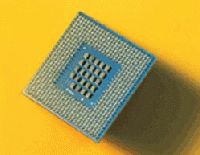MODEL- BX80546PG2800E
VENDOR- INTEL CORP.
FEATURES- Pentium 4 CPU- 2.8E GHz, Retail Boxed
Boxed product with fan and heatsink, NO memory.
478-pin, 800MHz FSB, 1 MB L2 cache and 90 nm die size.
Uses the Socket 478 FC-PGA2 (Flip Chip-Pin Grid Array) connector and
requires a 875P, 865PE, 865G, 865GV, and 848P chipset motherboards.
* Intel NetBurst Microarchitecture
Intel NetBurst microarchitecture delivers a number of innovative
features including Hyper-Threading Technology, hyper-pipelined
technology, 800, 533 or 400 MHz system bus, and Execution Trace Cache,
as well as a number of enhanced features such as Advanced Transfer
Cache, Advanced Dynamic Execution, enhanced floating-point and
multimedia unit, and Streaming SIMD Extensions 2 (SSE2). Further
enhancements in the next generation 90 nm process-based Pentium 4
processor include Streaming SIMD Extensions 3 (SSE3). Many of these
innovations and advances were made possible with improvements in
processor technology, process technology, and circuit design and could
not previously be implemented in high-volume, manufacturable solutions.
The features and resulting benefits of the microarchitecture are defined
below.
* Hyper-Threading Technology
Hyper-Threading Technology (HT Technology) is ground-breaking technology
that changes the landscape of processor design by going beyond GHz to
improve processor performance. It allows software programs to "see" two
processors and work more efficiently. This new technology enables the
processor to execute two series, or threads, of instructions at the same
time, thereby improving performance and system responsiveness. The
Pentium 4 processor supporting HT Technology is designed specially to
deliver immediate increases in performance and system responsiveness
with existing applications in multitasking environments (that is, where
two or more functions are running at the same time) and with many stand-
alone applications today. Furthermore, the Pentium 4 processor
supporting HT Technology provides performance headroom for the future.
* Hyper-Pipelined Technology
The hyper-pipelined technology of the Intel NetBurst microarchitecture
increases the pipeline depth delivering increased performance,
frequency, and scalability of the processor. One of the key pipelines,
the branch prediction/recovery pipeline, is implemented in 31 stages on
the 90 nm Pentium 4 processor, compared to 20 stages on the 0.13 micron
Pentium 4 processor.
* 800 MHz, 533 MHz or 400 MHz System Bus
In the Pentium 4 processor with 800 MHz system bus, the bus supports
Intel's highest-performance desktop processor by delivering 6.4 GB of
data-per-second into and out of the processor. This is accomplished
through a physical signaling scheme of quad-pumping the data transfers
over a 200 MHz clocked system bus and a buffering scheme allowing for
sustained 800 MHz data transfers. The same quad-pumping of data is true
for Pentium 4 processors with 533 MHz system bus (4.2 GB data-per-second
with a 133 MHz clocked system bus) and Pentium 4 processors with 400 MHz
system bus (3.2 GB data-per-second with a 100 MHz clocked system bus).
This compares to 1.06 GB/s delivered on the Pentium III processor's 133
MHz system bus.
* Level 1 Execution Trace Cache
The 90 nm Pentium 4 processor features 16-KB data cache compared to 8-KB
on the 0.13 micron Pentium 4 processor. In addition to the data cache,
the Pentium 4 processor includes an Execution Trace Cache that stores up
to 12-K decoded micro-ops in the order of program execution. This
increases performance by removing the decoder from the main execution
loop and makes more efficient usage of the cache storage space since
instructions that are branched around are not stored. The result is a
means to deliver a high volume of instructions to the processor's
execution units and a reduction in the overall time required to recover
from branches that have been mis-predicted.
* 1 MB or 512-KB Level 2 Advanced Transfer Cache
The 90 nm process-based Pentium 4 processor features 1-MB L2 Advanced
Transfer Cache (ATC) compared to 512-KB on the 0.13 micron process-based
Pentium 4 processor. The Level 2 ATC delivers a much higher data
throughput channel between the Level 2 cache and the processor core. The
Advanced Transfer Cache consists of a 256-bit (32-byte) interface that
transfers data on each core clock. As a result, the Pentium 4 processor
at 3.40 GHz can deliver a data transfer rate of 108 GB/s. This compares
to a transfer rate of 16 GB/s on the Pentium III processor at 1 GHz.
Features of the ATC include:
- Non-Blocking, full speed, on-die level 2 cache
- 8-way set associativity
- 256-bit data bus to the level 2 cache
- Data clocked into and out of the cache every clock cycle
* Advanced Dynamic Execution
The Advance Dynamic Execution engine is a very deep, out-of-order
speculative execution engine that keeps the execution units executing
instructions. It also includes an enhanced branch prediction algorithm
that has the net effect of reducing the number of branch mis-
predictions.
* Enhanced Floating-Point and Multimedia Unit
The Pentium 4 processor expands the floating-point registers to a full
128-bit and adds an additional register for data movement which helps
improve performance on both floating-point and multimedia applications.
* Streaming SIMD Extensions 3 (SSE3) Instructions
With the introduction of SSE2, the Intel NetBurst microarchitecture
extended the SIMD capabilities that MMX technology and SSE technology
delivered by adding 144 instructions. The next generation 90 nm process-
based Pentium 4 processor introduces the Streaming SIMD Extensions 3
(SSE3), which includes 13 additional SIMD instructions over SSE2. The 13
new instructions in SSE3 are primarily designed to improve thread
synchronization and specific application areas such as media and gaming.
www.intel.com
|

